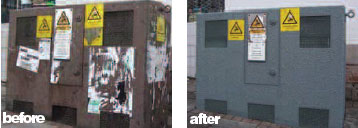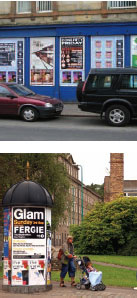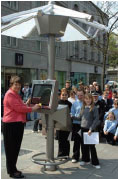Planning Advice Note 80: control and management of fly-posting
Planning Advice Note (PAN) 80 provides advice on how local authorities can effectively control and manage illegal poster advertising (flyposting) in urban and rural areas.
This document is part of a collection
Control and management of fly-posting
34. Effective control of fly-posting can be difficult and complete eradication of fly-posting in some urban areas may be impossible. Best practice suggests that no single measure is likely to be wholly effective, but a coordinated response that reflects the location and scale of the problem may deliver successful outcomes. Local authorities must decide which measures or solutions are the most appropriate for their areas. For example, in rural towns a simple solution may be to provide an information board, which can offer a central focal point which could hold a street map, events notices, and any additional fly-posting material.
35. The responsibility for combating fly-posting lies with local authorities. Best practice suggests that developing appropriate control measures is best secured through a combination of measures that encourage closer engagement between the various interests and better joined-up working within local authorities. Effective solutions to tackling fly-posting include the following:
- Strategic approach and partnering
- Prevention
- Removal of fly-posting
- Enforcement and prosecution
- Development through legal poster advertising sites
- Education to raise awareness
Strategic approach and partnering
36. Policy and strategies should include a mixture of preventative and enforcement approaches, with coordinated cross-departmental working including street cleansing, legal, licensing and planning responsibilities. Anti-fly-posting strategies must be suitably resourced and coordinated with other town centre initiatives and strategies to ensure long-term effectiveness. Town Centre Managers could potentially play a greater coordinating role in the process.
Business Improvement Districts ( BIDs) could also have a potential role to play in bringing parties together to take action on fly-posting. BIDs are a precisely defined geographical area of a town, city, industrial estate, business park or a rural area where business ratepayers have voted to invest collectively in local improvements in addition to those delivered by local government. Such local improvements could include action on fly-posting. BIDs will be developed, managed and paid for by the businesses where a majority have voted in favour of paying an additional levy on their rate bill to finance a BID. They are often, although not exclusively, a partnership arrangement through which the local business community and local authorities can take forward schemes which will benefit business.
Important elements of strategic management include:
- Employing a corporate approach within the council - collaboration between departments to ensure a joined-up approach
- Ensuring that there is a clear understanding of key departmental and officer responsibilities
- Develop an understanding about partnering with external parties
- Clear policy framework and guidelines
- Strategies appropriate to the location and scale of the problem
Prevention
37. The application of preventative coatings on control boxes, lamp-posts and street furniture can reduce the opportunities for fly-posting and make conditions more challenging for prospective fly-posters. There are a range of treatments, designed either to make it more difficult to stick posters or stickers on the treated surface or make it easier for the poster to be removed. Some take the form of 'anti-glue' paints, others create a roughened or stippled surface, deterring the use of the lamp-post or control box for fly-posting.
preventative coatings on control boxes, lamp-posts and street furniture can reduce the opportunities for fly-posting
Case Study 4:
Fly-posting Strategy, Aberdeen
 Aberdeen City Council is seeking to reduce incidences of illegal fly-posting across the city through the implementation of a fly-posting strategy. The strategy provides a raft of measures to help venues promote events without contributing to the deterioration of the city. The council has introduced a pilot scheme, involving the installation of authorised advertising pillars in a number of locations. The anti-fly-posting strategy includes:
Aberdeen City Council is seeking to reduce incidences of illegal fly-posting across the city through the implementation of a fly-posting strategy. The strategy provides a raft of measures to help venues promote events without contributing to the deterioration of the city. The council has introduced a pilot scheme, involving the installation of authorised advertising pillars in a number of locations. The anti-fly-posting strategy includes:
- Voluntary code of practice
- Information leaflets listing local legitimate advertising opportunities and contacts (e.g. newspapers, radio and on-street advertising)
- Environmental wardens to speak to venue managers, take down posters, record location, photograph and pass details to the fly-posting officer
- Three strike-letter warning system, accompanied by the information leaflet and mediation with fly-posters and venue managers
38. Fly-posting occurs most frequently on building and vacant site hoardings and vacant properties, which provide extensive flat and empty surfaces in prime advertising areas. To avoid fly-posting on these surfaces, construction companies and property owners can be encouraged, through planning conditions, to use a slatted hoarding, creating an uneven surface on which posters cannot be readily glued. Other solutions, including the maintenance and management of bus stops by advertising companies can also reduce the number of target fly-posting sites. Important elements of a prevention strategy include:
- Making it clear that fly-posting is illegal and unacceptable
- Reducing the number of available surfaces for fly-posting
-
- Planning conditions
- Construction site best practice
- Licensed poster sites operated by third party management
- Streetscape management
- Reducing the susceptibility of sites to fly-posting using anti-fly-posting measures
Removal of fly-posting
39. The most commonly used method of controlling fly-posting by local authorities is its removal by environmental wardens. Depending on the scale of the problem and the resources available, response times can be quick and control effective. Regular patrols of an area can help maintain a clean, safe and pleasant environment. Key town centre sites are often prioritised for early action. Speedy removal of fly-posters can deter fly-posting companies as posters are not displayed for any length of time in highly visible locations. The effectiveness of environmental wardens can be strengthened by the use of local authority hotline numbers for members of the public to report any incidences of fly-posting. Important elements for removal include:
- Removal of fly-posting can be legally undertaken by a local authority
- Early removal can be a deterrent - deferred action supports fly-posting
- Members of the public can report fly-posting using local authority hotline numbers
 Case Study 5:
Case Study 5:
Use of anti-fly-poster surfaces, Stirling
Stirling Council recently introduced an initiative to tackle fly-posting on control boxes throughout the town. Thirty control boxes in a pilot study area, which were regularly targeted by fly-posters, were coated with an anti-fly-poster coating, thus reducing the available space for fly-posting. Fly-posting on these structures has ceased.
Enforcement and prosecution
40. Preventative measures are not always effective in controlling fly-posting, particularly if the fly-posting company is well organised, resourced and determined. As a high proportion of fly-posting is undertaken by local businesses and community groups who are unaware of its illegality, the enforcement process should be clearly communicated to an offender through the use of a series of warning letters, setting out legislation and the legal process. Enforcement can act as a deterrent to fly-posting, but only if there is an established enforcement process operated by the local authority and the legal process is not overly burdensome. To enable this, local authorities must coordinate the roles of various internal departments (planning, legal, street cleansing) and work closely with the police and sheriffs courts. Important elements of enforcement include:
- Enforcement is critical to tackling the problem
- High profile enforcement action can raise awareness
- Establishing the local authority's willingness to prosecute can signal to other operators that the authority is prepared to take strong action.
- Securing media coverage particularly in local papers to raise awareness among local groups that fly-posting is illegal. This can also be used to promote the council's policy in respect of fly-posting for local events.
- CCTV can be an effective tool to identify offenders and collect evidence
- Working with police and sheriff courts
Case Study 6:
City centre rangers, Derry
The city centre rangers project sought to tackle illegal fly-posting in Derry by using the rangers to coordinate a system of licensed poster sites. Sixteen sites have been set up using specially manufactured boards located in areas where illegal fly-posting has been prevalent. Organisations are permitted to display one poster on a board once they have signed a code of practice. Derry City Council's quick response team remove all old posters at the end of each month and incidents of illegal fly-posting are dealt with as a matter of priority. The rangers seek to bring new sites into use and promote the scheme amongst local traders. The project has been effective in reducing the scale of a once serious eyesore, as well as cutting clean-up costs.
Development through legal poster advertising sites
41. Best practice has highlighted an approach adopted by a number of local authorities in the United Kingdom, involving the provision of formalised poster sites provided and managed either by the local authority or by a third party company. Typically, they consist of poster drums, poster boards across vacant shop frontages and poster boards along building site hoardings. If the sites are carefully managed, they can be made to appear neat and tidy, making an area feel cared for and orderly rather than threatening. The size and design of the structure should be appropriate to the location, adding an attractive streetscape element.
42. Pilot sites are a good way of establishing if authorised poster sites will work in a particular location or community, as part of a fly-posting strategy. The third party company is usually responsible for the management of the poster sites and in removing any fly-posting in an agreed zone around the site. The benefit to local businesses and community groups, who may have used fly-posting, is inexpensive advertising and guaranteed advertising space for an agreed period. The local authority may also use the sites to advertise local events and issues. Poster sites do not eradicate the problem, but can reduce the demand for fly-posting by official promotion of activities and events.
Important elements for legal poster site arrangements include:
- Partnership working between the local authority and the company managing the poster sites
- Coordinated action of environmental wardens, strategic planning, enforcement officers and street cleansing within a local authority to streamline the process
- Approved sites, including poster towers, drums and other boards located appropriately to ensure that they provide a legitimate alternative for potential
fly-posting companies or individuals - Management of poster sites, by third party organisations who can manage poster sites, support controls on fly-posting and contribute to venue operator education
Case Study 7:
'Street Bling' campaign, Westminister
Westminster Council has combined enforcement with a campaign known as the 'Street Bling' campaign. In addition to seeking prosecution of large multi-national companies employing fly-poster companies to advertise their products, an alternative approach was taken to achieve a real commitment from company directors to stop this practice.
The main objectives of the campaign were to:
- Apply pressure on company directors benefiting from the use of fly-posting by threatening prosecution
- Change the behaviour of directors and marketing departments to stop using illegal poster advertising
- Raise public awareness about fly-posting
The directors of 12 of the largest offenders were sent the 'Bling Bling' card requesting them to commit in writing to cease using fly-posting and warning they could face criminal prosecution if the fly-posting did not stop. Illegal fly-posters were covered by enforcement stickers saying "this poster is illegal" and directing the reader to a website address. Throughout the initiative, offending companies were quickly embarrassed in the media and on a 'name and shame' website. Westminster also have a hotline telephone number or online means for reporting fly-posting problems. The cost of the campaign was £3,000 and 10 out of 12 companies ceased fly-posting. Fly-posting has been reduced by 95% since the action was taken.
43. Local authorities should undertake a systematic assessment of the effectiveness of legitimate poster sites to ensure that the problem is not displaced to neighbouring areas. The success of the sites and scale of the fly-posting problem should be reviewed regularly to ensure that the best approaches are being employed to tackle the problem.
Education to raise awareness
44. An important part of local authorities' task in tackling fly-posting is raising awareness of the issues amongst the general public, local politicians, businesses and within local authorities. Local authorities should make it clear to members of the public their responsibilities as regards fly-posting, for example; where the responsibility for removal lies when fly-posting occurs on private property. There is a need to change the behaviour of businesses and individuals to desist from using fly-posting to advertise events and products. There are a number of methods that have been used including:
- Clean campaigns to raise public awareness
- Fly-posting fact sheets
- Clear notification process / local authority policy
- Corporate rolls of shame publicised on local authority websites identifying companies and individuals who have used fly-posting
- Commitment to good behaviour cards
- Campaigns to raise awareness in schools and colleges
Case Study 8: |
Case Study 9: |
Case Study 10: |
Case Study 11: |
Contact
There is a problem
Thanks for your feedback
 In Dundee the process to resolve widespread problems caused by fly-posting began a number of years ago. Local music promoters and licensees highlighted the need to promote local bands and events. A music promotions company from London agreed to provide money for timber and paint in return for 50% coverage for advertising artists' albums. A representative of the local promoters agreed to erect and maintain the sites and to put up posters weekly. The system worked so well that the council has erected six cast-iron information boards in the central / university area. Temporary poster boards, painted in Dundee's corporate colours, have been erected across vacant shop frontages and along building site hoardings.
In Dundee the process to resolve widespread problems caused by fly-posting began a number of years ago. Local music promoters and licensees highlighted the need to promote local bands and events. A music promotions company from London agreed to provide money for timber and paint in return for 50% coverage for advertising artists' albums. A representative of the local promoters agreed to erect and maintain the sites and to put up posters weekly. The system worked so well that the council has erected six cast-iron information boards in the central / university area. Temporary poster boards, painted in Dundee's corporate colours, have been erected across vacant shop frontages and along building site hoardings. A network of intelligent, interactive iKiosks have been installed across Aberdeen City, offering quick and easy access to a wide range of information and services. The project was led by Aberdeen City Council and its City Partners as part of its eGovernment modernisation initiative. The seven iKiosks have two 20-inch user friendly touch screens, providing residents, businesses and visitors with access to Council services, journey planning information and event promotion. It is hoped that the new iKiosks will help combat fly-posting by giving promoters an alternative way to publicise their event on the iKiosk Network.
A network of intelligent, interactive iKiosks have been installed across Aberdeen City, offering quick and easy access to a wide range of information and services. The project was led by Aberdeen City Council and its City Partners as part of its eGovernment modernisation initiative. The seven iKiosks have two 20-inch user friendly touch screens, providing residents, businesses and visitors with access to Council services, journey planning information and event promotion. It is hoped that the new iKiosks will help combat fly-posting by giving promoters an alternative way to publicise their event on the iKiosk Network. Stroud District Council introduced an initiative that allows those who wish to legally advertise an event to do so within a set of guidelines. The policy is known as Factor 4. Any organisations, for example night clubs, charities, schools and community organisations can advertise an event. The scheme allows the event to be advertised:
Stroud District Council introduced an initiative that allows those who wish to legally advertise an event to do so within a set of guidelines. The policy is known as Factor 4. Any organisations, for example night clubs, charities, schools and community organisations can advertise an event. The scheme allows the event to be advertised: